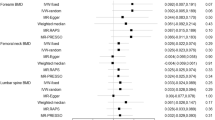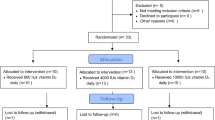Abstract
Farnesyl diphosphate synthase (FDPS) is necessary for osteoclast survival and activity and is considered as a major molecular target of aminobisphosphonates. Our objective was to analyze the influence of FDPS polymorphisms on bone mineral density (BMD) and the response to antiresortive drugs. Three single-nucleotide polymorphisms of FDPS were analyzed in 1186 postmenopausal women. There was only a marginally significant association of baseline hip BMD with rs11264359 alleles (P=0.043). However, among 191 women receiving antiresortive therapy, there was a very significant association between rs2297480 or rs11264359 alleles and the BMD changes after aminobisphosphonate therapy for an average period of 2.5 years (P=0.001). The genotype explained 7.2% of the variance in the BMD response. On the other hand, there was no association between the BMD changes after raloxifene therapy and any of the polymorphisms studied. These results suggest that common polymorphisms of the FDPS gene influence the response to aminobisphosphonates.
This is a preview of subscription content, access via your institution
Access options
Subscribe to this journal
Receive 6 print issues and online access
$259.00 per year
only $43.17 per issue
Buy this article
- Purchase on Springer Link
- Instant access to full article PDF
Prices may be subject to local taxes which are calculated during checkout



Similar content being viewed by others
References
Melton LJ . How many women have osteoporosis now? J Bone Miner Res 1995; 10: 175–177.
Favus MJ . Primer on the Metabolic Bone Diseases and Disorders of Mineral Metabolism, 6th edn. Lippincott Williams & Wilkins: Philadelphia, 2006.
Ettinger B, Black DM, Mitlak BH, Knickerbocker RK, Nickelsen T, Genant HK . Reduction of vertebral fracture risk in postmenopausal women with osteoporosis treated with raloxifene. Results from a 3-year randomized clinical trial. JAMA 1999; 282: 637–645.
Kanis JA, Johnell O, Black DM, Downs Jr RW, Sarkar S, Fuerst T et al. Effect of raloxifene on the risk of new vertebral fracture in postmenopausal women with osteopenia or osteoporosis: a reanalysis of the Multiple Outcomes of Raloxifene Evaluation trial. Bone 2003; 33: 293–300.
Black DM, Cummings SR, Karpf DB, Cauley JA, Thompson DE, Nevitt MC et al. Randomised trial of effect of alendronate on risk of fracture in women with existing vertebral fractures. Lancet 1996; 348: 1535–1541.
Karpf DB, Shapiro DR, Seeman E, Ensrud KE, Jonhston CC, Adami S et al. Prevention of nonvertebral fractures by alendronate. A meta-analysis. JAMA 1997; 277: 1159–1164.
Schnitzer T, Bone HG, Crepaldi G, Adami S, McClung M, Kiel D et al. Therapeutic equivalence of alendronate 70 mg once-weekly and alendronate 10 mg daily in the treatment of osteoporosis. Alendronate Once-Weekly Study Group. Aging (Milano) 2000; 12: 1–12.
Brown JP, Kendler DL, McClung M, Emkey RD, Adachi JD, Bolognese MA et al. The efficacy and tolerability of risedronate once a week for the treatment of postmenopausal osteoporosis. Calcif Tissue Int 2002; 71: 103–111.
Fogelman I, Ribot C, Smith R, Ethgen D, Sod E, Reginster JY . Risedronate reverses bone loss in postmenopausal women with low bone mass: results from a multinational, double-blind, placebo-controlled trial. BMD-MN Study Group. J Clin Endocrinol Metab 2000; 85: 1895–1900.
Body JJ, Bergmann P, Boonen S, Boutsen Y, Devogelaer JP, Goemaere S et al. Evidence-based guidelines for the pharmacological treatment of postmenopausal osteoporosis: a consensus document by the Belgian Bone Club. Osteoporos Int 2010; 21: 1657–1680.
Coxon FP, Thompson K, Rogers MJ . Recent advances in understanding the mechanism of action of bisphosphonates. Curr Opin Pharmacol 2006; 6: 307–312.
Russell RG, Watts NB, Ebetino FH, Rogers MJ . Mechanisms of action of bisphosphonates: similarities and differences and their potential influence on clinical efficacy. Osteoporos Int 2008; 19: 733–759.
von Knoch F, Jaquiery C, Kowalsky M, Schaeren S, Alabre C, Martin I et al. Effects of bisphosphonates on proliferation and osteoblast differentiation of human bone marrow stromal cells. Biomaterials 2005; 26: 6941–6949.
Riancho JA, Zarrabeitia MT, Gonzalez-Macias J . Genetics of osteoporosis. Aging Health 2008; 4: 365–376.
Richards JB, Kavvoura FK, Rivadeneira F, Styrkarsdottir U, Estrada K, Halldorsson BV et al. Collaborative meta-analysis: associations of 150 candidate genes with osteoporosis and osteoporotic fracture. Ann Intern Med 2009; 151: 528–537.
Gennari L . Pharmacogenomics of osteoporosis. Clin Rev Bone Miner Metab 2010; 8: 77–94.
Barrett JC, Fry B, Maller J, Daly MJ . Haploview: analysis and visualization of LD and haplotype maps. Bioinformatics 2005; 21: 263–265.
Conde L, Vaquerizas JM, Dopazo H, Arbiza L, Reumers J, Rousseau F et al. PupaSuite: finding functional single nucleotide polymorphisms for large-scale genotyping purposes. Nucleic Acids Res 2006; 34: W621–W625.
Reumers J, Conde L, Medina I, Maurer-Stroh S, Van Durme J, Dopazo J et al. Joint annotation of coding and non-coding single nucleotide polymorphisms and mutations in the SNPeffect and PupaSuite databases. Nucleic Acids Res 2008; 36: D825–D829.
Emaus N, Berntsen GK, Joakimsen RM, Fonnebo V . Longitudinal changes in forearm bone mineral density in women and men aged 25–44 years: the Tromso study: a population-based study. Am J Epidemiol 2005; 162: 633–643.
Ishani A, Blackwell T, Jamal SA, Cummings SR, Ensrud KE . The effect of raloxifene treatment in postmenopausal women with CKD. J Am Soc Nephrol 2008; 19: 1430–1438.
Ralston SH . Osteoporosis as an hereditary disease. Clin Rev Bone Miner Metab 2010; 8: 68–76.
Hernandez JL, Riancho JA . Pharmacogenomics of osteoporosis. Curr Pharmacogenom 2007; 5: 214–227.
Kruk M, Ralston SH, Albagha OM . LRP5 polymorphisms and response to risedronate treatment in osteoporotic men. Calcif Tissue Int 2009; 84: 171–179.
Levy ME, Parker RA, Ferrell RE, Zmuda JM, Greenspan SL . Farnesyl diphosphate synthase: a novel genotype association with bone mineral density in elderly women. Maturitas 2007; 57: 247–252.
Marini F, Falchetti A, Silvestri S, Bagger Y, Luzi E, Tanini A et al. Modulatory effect of farnesyl pyrophosphate synthase (FDPS) rs2297480 polymorphism on the response to long-term amino-bisphosphonate treatment in postmenopausal osteoporosis. Curr Med Res Opin 2008; 24: 2609–2615.
Choi HJ, Choi JY, Cho SW, Kang D, Han KO, Kim SW et al. Genetic polymorphism of geranylgeranyl diphosphate synthase (GGSP1) predicts bone density response to bisphosphonate therapy in Korean women. Yonsei Med J 2010; 51: 231–238.
Adami S, Giannini S, Bianchi G, Sinigaglia L, Di Munno O, Fiore CE et al. Vitamin D status and response to treatment in post-menopausal osteoporosis. Osteoporos Int 2009; 20: 239–244.
Epstein S . The roles of bone mineral density, bone turnover, and other properties in reducing fracture risk during antiresorptive therapy. Mayo Clin Proc 2005; 80: 379–388.
Cummings SR, Karpf DB, Harris F, Genant HK, Ensrud K, Lacroix AZ et al. Improvement in spine bone density and reduction in risk of vertebral fractures during treatment with antiresorptive drugs. Am J Med 2002; 112: 281–289.
Acknowledgements
This work was supported by grants from Fundación Areces. CS has a fellowship of the Instituto de Formación e Investigación Marqués de Valdecilla (IFIMAV) and the Instituto de Salud Carlos III.
Author information
Authors and Affiliations
Corresponding author
Ethics declarations
Competing interests
JMO, JLH, JGM and JAR have received research support, travel reimbursements or lecture fees from MSD, Servier, Lilly, Amgen, Procter & Gamble, Nycomed and Novartis. MTZ and CS have no conflict of interest to declare.
Rights and permissions
About this article
Cite this article
Olmos, J., Zarrabeitia, M., Hernández, J. et al. Common allelic variants of the farnesyl diphosphate synthase gene influence the response of osteoporotic women to bisphosphonates. Pharmacogenomics J 12, 227–232 (2012). https://doi.org/10.1038/tpj.2010.88
Received:
Revised:
Accepted:
Published:
Issue Date:
DOI: https://doi.org/10.1038/tpj.2010.88
Keywords
This article is cited by
-
A Genome-Wide Association Study of Bisphosphonate-Associated Atypical Femoral Fracture
Calcified Tissue International (2019)
-
Genetic polymorphisms in the mevalonate pathway affect the therapeutic response to alendronate treatment in postmenopausal Chinese women with low bone mineral density
The Pharmacogenomics Journal (2015)
-
Exon array analysis reveals genetic heterogeneity in atypical femoral fractures. A pilot study
Molecular and Cellular Biochemistry (2015)
-
Polymorphisms of the farnesyl diphosphate synthase gene modulate bone changes in response to atorvastatin
Rheumatology International (2014)
-
Pharmacogenetics of Osteoporosis: What is the Evidence?
Current Osteoporosis Reports (2012)



